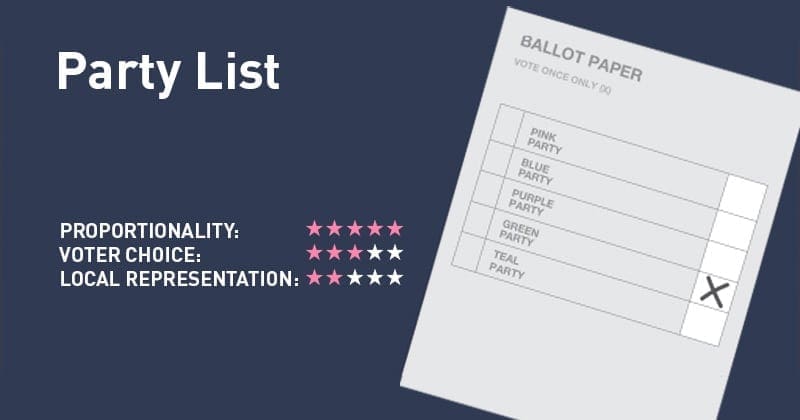
In Party List systems, seats in parliament closely match how many votes each party receives, but there is often a weaker constituency link.

Party Lists are the most popular way to elect representatives in the world, with more than 80 countries using a variation of this system to elect their parliament.
Rather than electing one person per area, in Party List systems each area is bigger and elects a group of MPs that closely reflect the way the area voted. At the moment we have 650 constituencies, each electing 1 Member of Parliament (MP); under a Party List system we might have 65 constituencies each electing 10 MPs.
Closed List : Each party publishes a list of candidates for each area. On polling day the ballot paper just has a list of parties. Voters mark the party they support.
In this system, a party gets seats roughly in proportion to its vote, and seats are filled depending on the order of the list the party choose in advance.
Open List: On the ballot paper, each party has a list of candidates.
The more votes a candidate gets, the more likely to be in the party’s group of MPs that get elected. A vote for a candidate is counted as a vote for their party when it is decided how many seats each party should receive. This means it is possible for a vote for a candidate to help a candidate a voter dislikes, if that candidate is popular with the supporters of the rest of their party.
In some countries, you can just vote for a party and leave the ordering of the candidates up to the other voters.
Semi-Open List: In a semi-open list voters are presented with a ballot with the option to vote for a candidate or a party.
Unlike in an open list, voting for a party is taken as an endorsement of the order of candidates chosen by the party. With enough individual votes, candidates can still move up the ordering though.
Countries with party-list PR tend to have lots of parties as list systems are highly proportionate. This means that coalition is often the norm. With a lower barrier to entry, new parties can start and be successful if the larger parties do not understand new social issues. Many countries use legal thresholds, generally 4 or 5% to stop parties with very low support winning seats.
It is possible to have party-lists with either very large or smaller constituencies. For instance, in the Netherlands and Israel the entire country is one big constituency. In other countries smaller constituencies are used. For instance in Finland and Spain provinces are used.
The advantage of smaller constituencies is that MPs are closer to local issues, as different areas will have different problems. But constituencies with fewer MPs are also less proportionate as you need more votes to win an MP.
Party lists, as the name suggests, are based on the idea of political parties, so independent candidates have to create a ‘party list’ of one. If they win more votes than they need to get elected these votes are wasted.